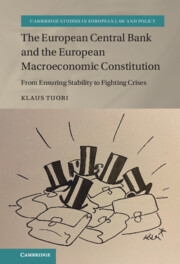 The European Central Bank and the European Macroeconomic Constitution
The European Central Bank and the European Macroeconomic Constitution from Part III - The ECB from a Central Bank of Stability to a Central Bank of Crisis
Published online by Cambridge University Press: 15 September 2022
The last chapter is devoted to the fundamental transformation of the European Macroeconomic Constitution and particularly its objectives during the last decade that has also changed the ECB from a central bank of stability to a central bank of crisis. The great promise of the EMU that the properly designed and constitutionally protected macroeconomic framework would guarantee economic stability and prosperity has failed. In particular, the sole focus on price stability objective and constraints for national economic policy failed to ensure economic, fiscal, or even financial stability. The ECB 2021 strategy review tried to reflect these changes. The chapter analyses, how the ECB could seek to readjust its role in the euro area economy by incorporating new objectives. The discussion starts by analysing how and why the role of price stability has changed, which is followed by assessments of how the broader stability objective have gained more practical and eventually also formal importance. Furthermore, the objectives of structural economic adjustment and increasingly environmental sustainability are discussed as the new candidates for the objectives of the European Macroeconomic Constitution and the ECB. As an Epilogue, the book concludes with a broader forward-looking perspective on the options available.
To save this book to your Kindle, first ensure [email protected] is added to your Approved Personal Document E-mail List under your Personal Document Settings on the Manage Your Content and Devices page of your Amazon account. Then enter the ‘name’ part of your Kindle email address below. Find out more about saving to your Kindle.
Note you can select to save to either the @free.kindle.com or @kindle.com variations. ‘@free.kindle.com’ emails are free but can only be saved to your device when it is connected to wi-fi. ‘@kindle.com’ emails can be delivered even when you are not connected to wi-fi, but note that service fees apply.
Find out more about the Kindle Personal Document Service.
To save content items to your account, please confirm that you agree to abide by our usage policies. If this is the first time you use this feature, you will be asked to authorise Cambridge Core to connect with your account. Find out more about saving content to Dropbox.
To save content items to your account, please confirm that you agree to abide by our usage policies. If this is the first time you use this feature, you will be asked to authorise Cambridge Core to connect with your account. Find out more about saving content to Google Drive.